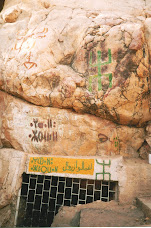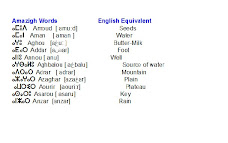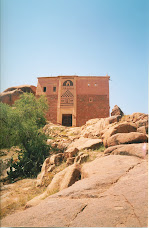“ ….. He keeps a frightened eye on me as he brings the basin and kettle to Monsieur Lapandery (….) serves us little glasses of smoking coffee , and hot Couscous made of boiled cucumbers , egg-plant , peppers , carrots and marrow, walled in with steamed white millet.” P.164
Some of the food rituals among Berbers are that you need to name God before you eat and you have to praise him for giving the bounty of food and drink. Berbers use their right hand to eat. If you use both hands, It is a sign of bad manners. Most of the time, it is not acceptable for children to eat outside unless it was while working in the fields (agriculture). People in Berber communities share food on one plate and sometimes share the same glass of water . While eating you are expected to eat what is in front of you.
Another element which is need a deep consideration is the serving of mint flavored tea. A symbol of hospitality, you can not refuse an invitation to tea. There are several rituals related to tea drinking. What makes good tea or bad tea? According to Berber culture tea is supposed to be prepared by a old wise person. The table master is a well-known person having experience of making good tea. Tea is served is small tea glasses and it should have a white foamy 'head' or 'turban' at the top of the glass. Otherwise it is a sign of bad tea.
Berbers celebrate the New Year in mid January, They have a special meal for that night which was this year the 14th of January. They take twelve dates or nuts they named by the month of year and then make a wish. They serve a special meal with a date hidden inside. The person, who finds that hidden date, will get the key to the main storage where they keep all the crops and stored foods .Berbers think that that lucky person will manage food wisely. A detailed account of this is reported by H. Stroomer in his book: Textes Berbères des Guendiwa et Goundafa.
To sum up, there are several elements related to eating and drinking habits in Berber communities that are full of symbolic significance.
1-('Berber') is used in this paper to refer to the first inhabitants of North Africa , and those people call themselves “ Imazighen” which mean literary the free people. They speak a language called “Tamazight”.
Stroomer, H. (2001). Textes Berbères des Guendiwa et Goundafa. EDISUD.
Andrews, C.E. (1922). Old Morocco and The forbidden Atlas. George H Doran Company.











1 comment:
c 'est une trés bonne idée de montrer que la langue amazighienne est une langue trés riche..et qu elle mérite une grande considération..
Post a Comment